by Scott Jackson | Sep 12, 2017

In the photo is a Houston area home with storm damage after hurricane Harvey . There are plenty of ways to help. See volunteer and donation opportunities at www.nvoad.org/voad-members/national-members . Photo by Christy Volanski.
Recent images of hurricane Irma and Harvey’s devastating impacts remind all of us living along the Gulf just how powerful tropical cyclones can be. There’s a Gulf of Mexico kinship we all feel. Even more today since Irma has put our Florida homes and cities in the news just like Harvey did a few days ago in Texas.
Ivan, Dennis, Katrina, and Ike are names that conjure personal memories of past storms that I’ve lived through and helped others recover from. Every storm’s impact and response is different but the main question is always the same, “What can I do to help?”
Help is the keyword. Showing up in a disaster area without a plan, without training, or without the support of a recognized and welcomed organization is potentially risky. Rogue, unaffiliated volunteers put themselves and others at risk by being in the wrong place at the wrong time. Just showing up is not help but compounds emergency recovery efforts.
Donating money is the best method to quickly provide resources where they are needed the most. Donating the wrong items can burden damaged communities and waste efforts. A better place to start to help is Volunteer Organizations Active in Disaster or VOAD for short, http://NVOAD.org . VOAD includes well known response organizations like the Red Cross and Salvation Army, and other non-profit or faith-based organizations which specialize in community disaster recovery. You can visit their webpage to donate to specific recovery efforts and to learn about volunteer opportunities. VOAD organizations support volunteers with training, coordination with emergency managers, and often provide volunteers with some types of work insurance coverage. Similar opportunities and information can also be found with Volunteer Florida at https://www.volunteerflorida.org/irma
The severe impacts from Irma and Harvey will extend recovery for several years, so there will be ample opportunity for individuals to help immediately and into the foreseeable future. Harvey’s flooding reminds me of Katrina. I volunteered months after the storm with a faith-based organization to help rebuild a church in St. Bernard Parish. This church became a focal point to help distribute clothing, food and other resources as local families recovered. Another time we assisted flood victims on the Wakulla River, volunteering with the Salvation Army. This organization provided us with training and support as we helped with mud-outs, removing sediment flooded homes. Look for similar opportunities in responding to Harvey and Irma. These are just two examples of many ways you can help make a difference.
Now is the perfect time to contact one of the VOAD organizations or with Volunteer Florida if you are interested in volunteering. Floodwaters will soon crest, safe access will be restored, and assessments will be completed. As a result, restoration efforts will be prioritized, timed, and coordinated to meet local needs. Quality trained volunteers are needed to help life return to normal. You can be the answer to prayers all across the Gulf.
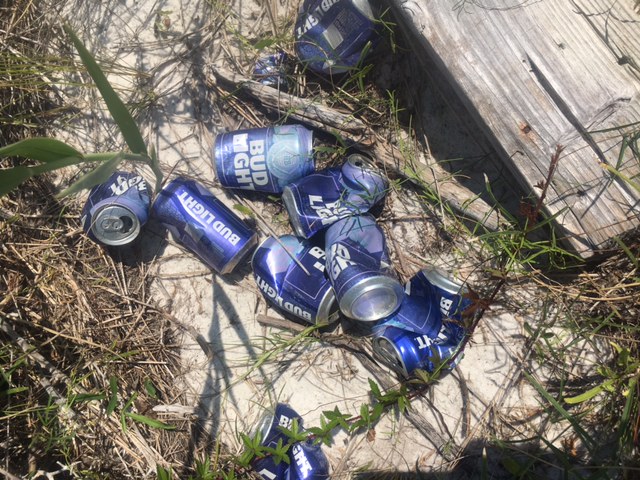
by Rick O'Connor | Sep 2, 2016
People have been trying to do something about marine debris, and solid waste in general, since we saw the commercial of the crying Indian in the early ‘70’s. Have we made any improvement?
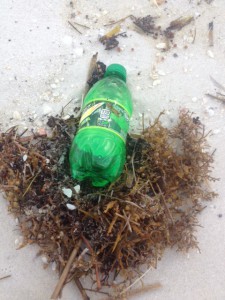
A variety of plastics ends up in the Gulf. Each is a potential problem for marine life. Photo: Rick O’Connor
Yes… but there are still problems to deal with.
Literally millions of tons of solid waste are produced and disposed of each year. According to the 16th edition of Living in the Environment by G. Tyler Miller and Scott Spoolman (2011), Americans generate 2.5 million tons of solid waste each year. This total could fill enough garbage trucks to circle the earth 8 times – bumper to bumper. Though we only make up 4.6% of the world’s population we generate 33% of world’s solid waste. Scientists have been recommending that we reduce the amount of solid waste we produce for some time… but we are not.
So what are we going to do about the problem?
Well, if you are not going to reduce the amount generated you have basically three choices
- Bury it
- Burn it
- Recycle it
Currently Americans are burying about 54% of their solid waste, 25% is recycled, 14% is incinerated, 7% is composted. Comparing our recycling efforts to other nations we are not doing too bad, but there is room for improvement – there is actually a need to improve. The majority of the solid waste we throw away actually ends up in the environment. It has been determined that 80% of the plastics in the ocean come from land – and much of this was thrown in the trash by people who were doing the right thing.
To reduce waste, we need to know what it is we are throwing away. According to Miller and Spoolman the top five items we throw away are:
- Paper/cardboard – 37%
- Yard waste – 12%
- Food – 11%
- Plastics – 11%
- Metal – 8%
Most of these can be recycled or composted – should be easy – but we are not doing it as often as we should.
What about local marine debris?
I have been working with the local group OCEAN HOUR. Ocean Hour cleans a shoreline somewhere in the Escambia / Santa Rosa area every weekend (check out their Facebook page or the Escambia County Extension website to know where). Volunteers come out to help remove the waste and Ocean Hour provides buckets, tongs, and gloves for them to do so. Sea Grant, Escambia County, and students from local schools help to gather data from what they are collecting.
| TOP FIVE ITEMS |
2015 |
2016
|
| 1 |
Cigarette butts |
Cigarette butts
|
| 2 |
Food wrappers |
Foam
|
| 3 |
Plastic bottles |
Plastic bottles
|
| 4 |
Plastic pieces |
Glass bottles
|
| 5 |
Foam |
Food wrappers
|
Plastics
There has been a lot of concern about plastics in the environment. Paper, food, and yard waste are oxygen demanding waste, and need to be reduced, but their life span in the ocean is much shorter than plastic. Plastics are made using large polymers produced while refining oil and natural gas. There are about 46 different types and many products are a mix of different polymers. This actually makes some forms difficult, and costly, to recycle. Most counties can recycle #1 and #2 forms of plastic. Water bottles are made from a form of plastic called polyethylene terephthalate (PET). These are easier and less costly to recycle than some other forms but they must be disposed of separately. One PVC bottle in a truck load of plastic water bottles will keep the entire truck load from being recycled.
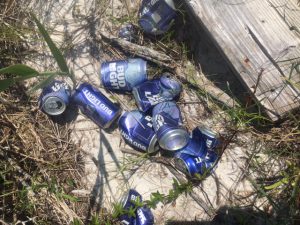
Another issue, which you will be hearing more about this month, are microplastics. Much of the plastic that reaches the ocean will break down due the sun and the ocean elements. These bring on their own problems – read more about microplastics on this website or the link above.
We certainly encourage all folks who live in the panhandle, or who are visiting, to reduce the amount of solid waste they generate – recycle or compost what you can – and participate in community cleans ups – such as those put on by Ocean Hour. The International Coastal Clean Up will be September 17. Check the Escambia County website for locations. We can do this!
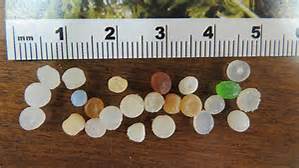
by Rick O'Connor | Sep 2, 2016
Going along with the International Coastal Clean Up, UF/IFAS Extension will be promoting September as Microplastics Awareness month.
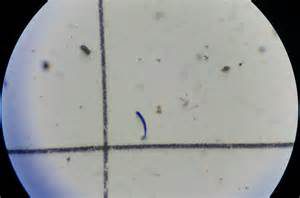
The most common form of microplastic are fibers.
Photo: UF IFAS St. johns County
If you have not heard, microplastics are small pieces of plastic < 5mm in diameter. Some are fragments from larger pieces of plastic that have been broken down by the elements, others are produced at that size to be used in products such as stuffed animals or melted in molds to produce larger products. Some microplastics are small beads used in cosmetics, but the most common are fibers from our linens and clothing. These fibers are removed during washing and travel through the drain and sewer systems until the reach the sea. Either way – they end up in our coastal waterways where they have had some negative impacts on marine life.
Some impacts include:
- Consumption by plankton give the sensation of being full – thus they stop eating.
- A decrease in the reproductive success of oysters.
- Negative impacts on hatching rates and activity rates of some species of larval fish, making them more prone to predation.
- They have also been found to be more common in sea salt and have been found in the guts of some fish and bivalves sold at seafood markets on the west coast. We are not sure of the impact of human consumption of these products.
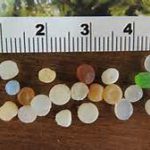
Small microbeads called “nurdles” are used to fill stuffed animals and to make larger plastic products.
Photo: UF IFAS St. Johns County
During the month of September, we will be posting short articles on our Facebook pages and on Panhandle Outdoors. Extension will also host a webinar on the topic September 16. It will be broadcast from 12:15 to 1:00 PM EDT. To register for this webinar go to https://www.eventbrite.com/e/whats-the-big-deal-with-microplastics-webinar-tickets-27070847634. Please like and share these with your friends so that we can make more people aware of this problem. If you would like to have a public presentation on microplastics, contact your county Extension office. Check in on these posts throughout the month.
http://facebook.com/NEFLSeaGrant
https://www.facebook.com/MicroplasticAwarenessProject
www.plasticaware.org







